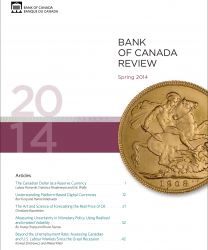Bank of Canada Review - Spring 2014
The five articles in this issue present research and analysis by Bank staff covering a variety of topics: the growth of Canadian-dollar-denominated assets in official foreign reserves; the emergence of platform-based digital currencies; methods of forecasting the real price of oil; measures of uncertainty in monetary policy; and the recent performance of the labour market in Canada and the United States.
The Bank of Canada Review is published twice a year. Articles undergo a thorough review process. The views expressed in the articles are those of the authors and do not necessarily reflect the views of the Bank.
The contents of the Review may be reproduced or quoted, provided that the publication, with its date, is specifically cited as the source.
